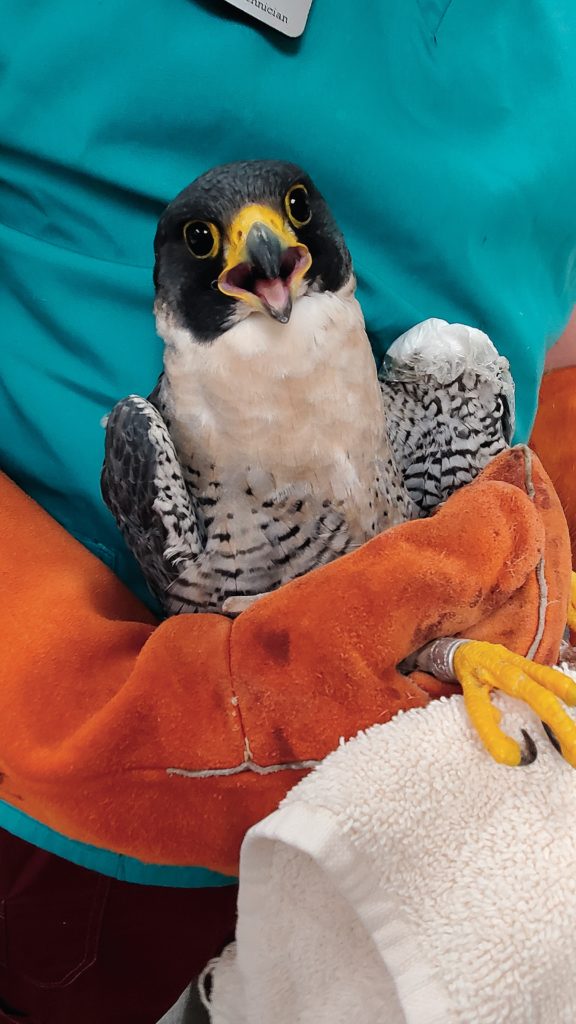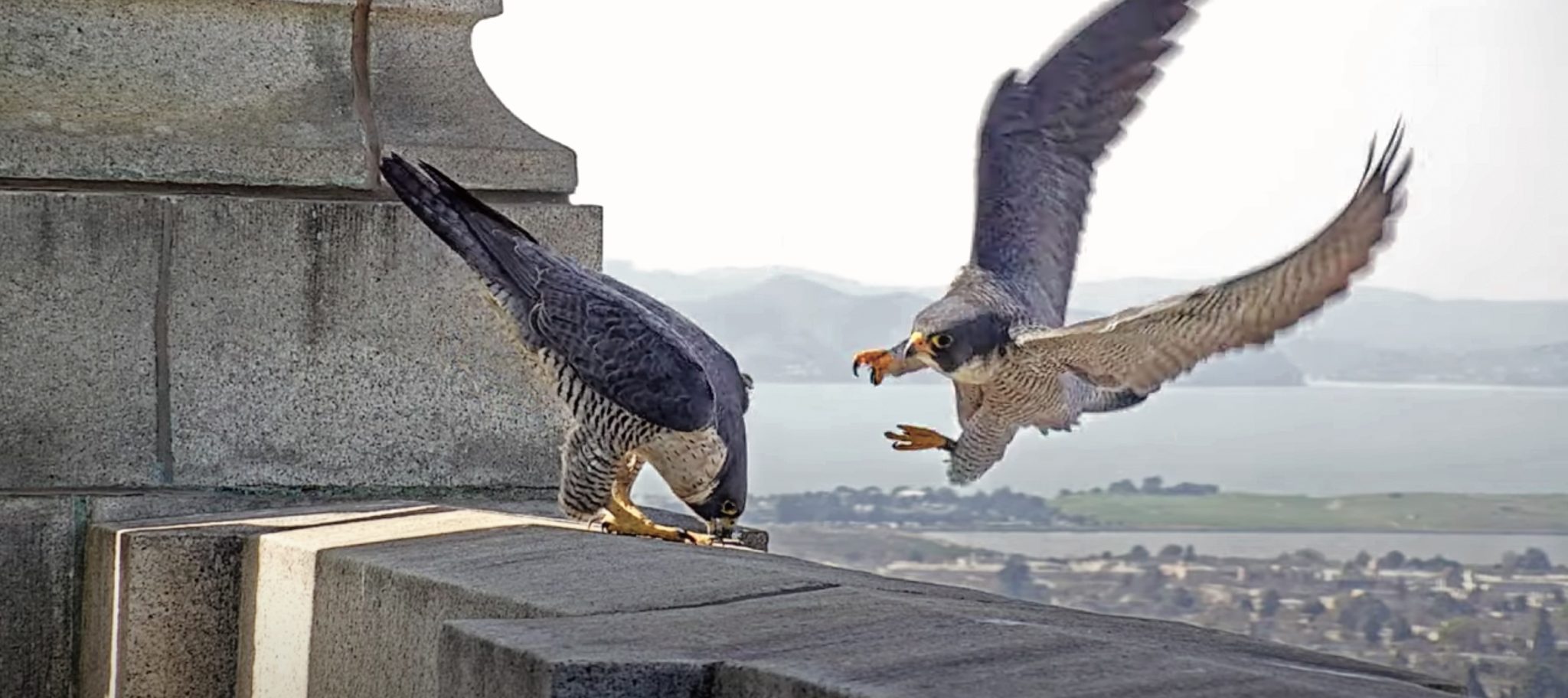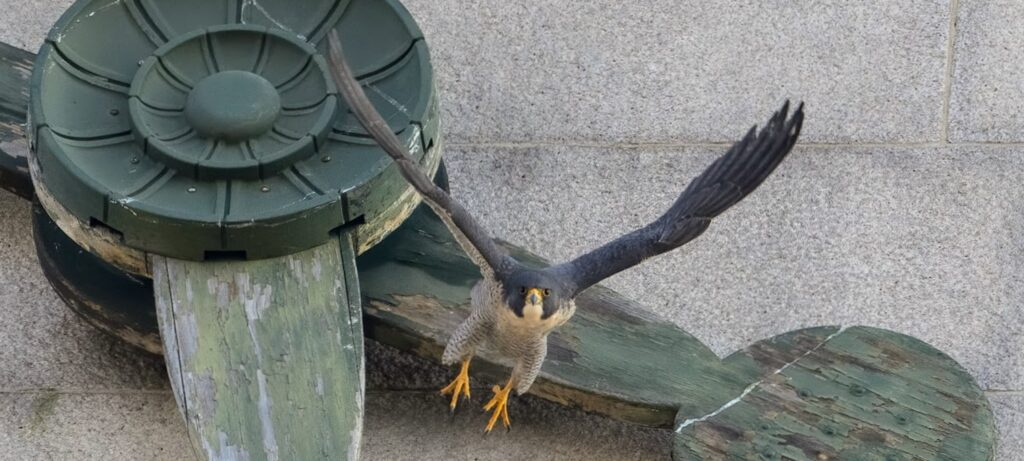If Berkeley has a celebrity couple, it’s Annie and Grinnell, the peregrine falcons who alighted on the Campanile and have called it home since late 2016. Year after year, the lovebirds have nested and fledged their chicks, generating 24/7 entertainment for those tuning in to the Cal Falcons live cams (first installed in 2019). Viewers have had unprecedented access to the daily lives of a falcon family: first meals, first flights, the one kid who just won’t leave the nest. It was like Jon & Kate Plus 8, but with a lot more dead pigeons and doves.
Starting in late October, though, the Cal Falcons show veered into melodrama. Grinnell was caught in a fight with a pair of falcons and later found sitting on a trash can at the Berkeley Tennis Club, wounded in multiple places. He was taken to the Lindsay Wildlife Rehabilitation Hospital in Walnut Creek and expected to recover. In the meantime, though, one of his assailants, a male, began stopping by the Campanile and pursuing Annie. Soon, Annie and the falcon were seen flying together and bowing to one another—a sign of courtship.
For Annie and Grinnell superfans, this was an explosive development. Peregrine falcons generally mate for life, but if one partner doesn’t return or can’t reclaim its territory after an injury, the other will often accept a new mate. “No, Annie!!” one Facebook follower pleaded in response to a video of Annie and the new falcon. “Grinnell is still alive! Don’t fall for this new fellow!!”
On November 16, Lindsay Wildlife gave Grinnell a clean bill of health and released him from outside the Lawrence Hall of Science the following day.
For weeks, the Cal Falcons community was on edge. Grinnell did return to the Campanile, but it seemed his competitor wasn’t going anywhere, continuing to socialize with Annie up until mid-December. Not until the morning of New Year’s Day did fans witness the reunion they were hoping for: Annie and Grinnell, bowing in courtship to one another on a ledge.
After all the turmoil, would it be happily ever after? Probably not, said Sean Peterson, Ph.D. ’21, who runs the Cal Falcons social media operation with his wife, Lynn Schofield, a biologist at the Institute for Bird Populations. “Unfortunately for fans of Annie and Grinnell, it’s a matter of time before one or both of them are replaced,” he explained.

Peterson seemed prescient when, in late February, Annie went missing and experts presumed she was either injured or dead.
As new female falcons began circling the Campanile, Annie and Grinnell devotees were heartbroken. “I know the world is falling to pieces, but our fav pair of falcons too?” wrote one Instagram fan.
Then, on March 1, after almost a week away, Annie returned, seemingly unscathed, and more than one Twitter follower admitted bursting into tears at the news.
For all its vicissitudes, the ongoing saga highlights how well peregrines are doing in general. “Even 15 years ago, this kind of stuff would have been really rare,” Peterson says. In 1946, an estimated 100 pairs of peregrine falcons resided in California; 24 years later, a survey found only two. This precipitous decline was linked to the use of DDT, a pesticide that thinned the eggshells of many predatory birds. In 1970, two years before DDT was outlawed in the United States, peregrines were among the earliest creatures placed on the Endangered Species List. Their recovery was largely driven by The Peregrine Fund, cofounded by Cornell ornithologist Tom Cade. The organization bred and released more than 4,000 falcons between 1974 and 1999, when peregrines were officially delisted as an endangered species.
That’s why Peterson says the winged drama atop the Campanile is ultimately good news. It shows that “peregrine falcons are recovering really, really well from the brink of extinction,” he explains.
One surprise of the peregrine resurgence, in California and beyond, has been just how well these birds take to urban environments. In the wild, peregrines are cliff dwellers, but it’s become increasingly common for them to nest atop skyscrapers and church towers. A 2016 University of Illinois Chicago study found that it is not unusual for urban peregrines to produce more eggs than those in their natural habitat. Annie and Grinnell, for instance, have thrived on campus, hatching 13 chicks in four years.
It’s gratifying for scientists like Peterson to see the Berkeley falcons flourish, but it’s been a treat for hobbyists as well. Oliver James, MPP ’21, M.S. ’21, a lifelong birdwatcher and author of the field guide Birds of Berkeley, first started observing Annie and Grinnell when he was on campus. Now in Philadelphia, James has been following them via social media and enjoying “the drama” and “anthropomorphizing” as people all over the world tuned in to watch the falcons.
“It’s been a pretty awesome birding opportunity for folks who are not really associated with the campus or wouldn’t even call themselves birders,” he says. “There’s this opportunity to look at the way raising a falcon family actually works.”
UPDATE: Not long after this article appeared, Grinnell was found dead, apparently hit by a car. Since then, Annie has taken up with a new suitor.
If you would like to watch a video of the drama, check out our YouTube Video “Strange Peregrinations: Annie and Grinnell’s Rocky Love Story.” https://www.youtube.com/watch?v=zWEnFQ6U9MM&t=11s





















